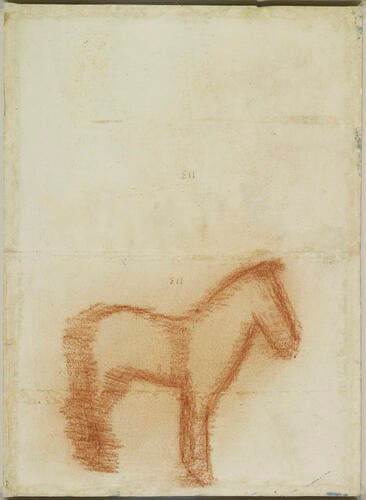-
1 of 253523 objects
A horse in left profile, with measurements c. 1490
Metalpoint and pen and ink on blue-grey prepared paper, the outlines incised; sharply folded, the upper half damaged by damp | 32.4 x 23.7 cm (sheet of paper) | RCIN 912319
-
A study of the hind-quarters and legs of a horse, in profile to the right, with a few measurements; a drawing of waving hair/flowing water?; the words 'de Lionardo'; the fore-leg and off hind-leg of a horse with measurements. In the lower half of the sheet is a study of a full-length horse in profile to the left, and measurements; a bent fore-leg and measurements, and shoulders and a fore-leg with measurements.
Alongside his studies of human proportion around 1490 (see RCIN 919132, 919136 etc), Leonardo worked intensively on the proportions of the horse, prompted by a commission to sculpt a huge bronze equestrian monument to Francesco Sforza (1401-66), the former Duke of Milan. Leonardo surveyed different breeds of horse, and the note above the main drawing here, gianecto grosso di messer galeazo, records that his subject was a ‘large jennet’ belonging to Galeazzo da Sanseverino, the Captain-General of the Milanese army.
Leonardo’s equine studies were fundamentally different from his contemporary studies of human proportion because the horse, unlike man, held no central place in the scheme of the universe, and could therefore not be expected to have any divinely harmonious relationships between its parts. To ascertain its form, abstract speculation was of no use: one simply had to measure the beast. The density of measurement in Leonardo’s equine studies went far beyond what was of direct practical use to the artist, but they were methodologically in advance of his studies of the human form, for he was unencumbered by an urge to find correspondences and harmonic proportions.
Measuring a live horse must have been slow work, and it is probable that Leonardo annotated the drawings on the basis of measurements dictated to (or by) an assistant. The larger distances were presumably measured with a tape; the thicknesses of the legs were obtained with caliper compasses, four of which Leonardo drew in a notebook compiled at the end of the 1480s (Paris MS B, ff.52v, 57v, 58v). Leonardo used as his unit the horse’s head or testa (here noted as T, and measured from the tip of the muzzle to the base of the ears), divided into sixteenths, and with subdivisions of these sixteenths expressed either as fractions (halves, thirds and quarters of a sixteenth, as seen here) or in terms of a unit itself one-sixteenth of a sixteenth, and thus 1/256 of a head – less than 2 mm. This system is similar to that outlined by Leon Battista Alberti in his treatise De statua (c.1443-52), in which he moved away from a harmonic system of division of the human body, instead dividing each foot into 10 unceolae and 100 minutae of roughly 3 mm.
The sheet was folded in two before Leonardo began work on it, and further metalpoint studies in the upper half were effaced when the blue preparation was damaged by damp at some point in the sheet’s history.
Text adapted from M. Clayton and R. Philo, Leonardo da Vinci: Anatomist, 2012, no. 18.Provenance
Bequeathed to Francesco Melzi; from whose heirs purchased by Pompeo Leoni, c.1582-90; Thomas Howard, 14th Earl of Arundel, by 1630; probably acquired by Charles II; Royal Collection by 1690
-
Creator(s)
Acquirer(s)
-
Medium and techniques
Metalpoint and pen and ink on blue-grey prepared paper, the outlines incised; sharply folded, the upper half damaged by damp
Measurements
32.4 x 23.7 cm (sheet of paper)
Markings
watermark: Paper coated with blue preparation, no transmitted light, but 8-lobed flower visible on verso (48 by 44 mm)
Category
Object type(s)
Other number(s)


